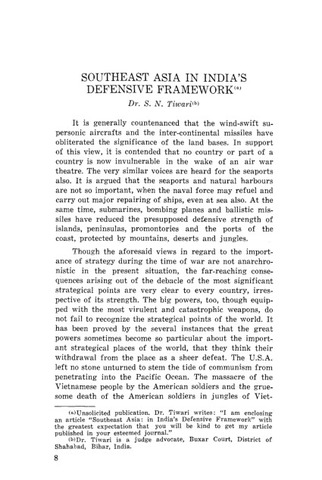Показать сокращенную информацию
Southeast Asia in India's defensive framework
| dc.contributor.author | Tiwari, S. N. | |
| dc.date.accessioned | 2023-08-10T01:07:10Z | |
| dc.date.available | 2023-08-10T01:07:10Z | |
| dc.date.issued | 1968 | |
| dc.identifier.uri | https://hdl.handle.net/20.500.12852/2743 | |
| dc.description | Journal Article | en_US |
| dc.description.abstract | Unsolicited publication. Dr. Tiwari writes: “I am enclosing an article “Southeast Asia: in India’s Defensive Framework” with the greatest expectation that you will be kind to get my article published in your esteemed journal.” Dr. Tiwari is a judge advocate, Buxar Court, District of Shahabad, Bihar, India. It is generally countenanced that the wind-swift supersonic aircrafts and the inter-continental missiles have obliterated the significance of the land bases. In support of this view, it is contended that no country or part of a country is now invulnerable in the wake of an air war theatre. Though the aforesaid views in regard to the importance of strategy during the time of war are not anarchro-nistic in the present situation, the far-reaching consequences arising out of the debacle of the most significant strategical points are very clear to every country, irrespective of its strength. | en_US |
| dc.language.iso | en | en_US |
| dc.publisher | Central Philippine University | en_US |
| dc.subject.lcsh | Southeast Asia | en_US |
| dc.subject.lcsh | India | en_US |
| dc.subject.lcsh | Military readiness | en_US |
| dc.subject.lcsh | Defensive (Military science) | en_US |
| dc.title | Southeast Asia in India's defensive framework | en_US |
| dc.type | Article | en_US |
| dcterms.accessRights | Publicly accessible | en_US |
| dc.citation.firstpage | 8 | en_US |
| dc.citation.lastpage | 22 | en_US |
| dc.citation.journaltitle | Southeast Asia Quarterly | en_US |
| dc.citation.volume | 3 | en_US |
| dc.citation.issue | 1 | en_US |


